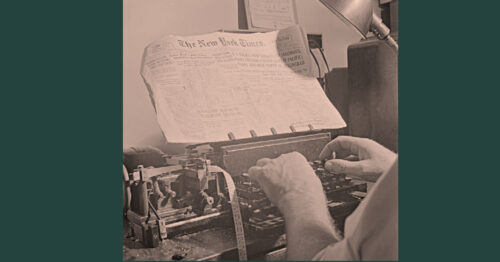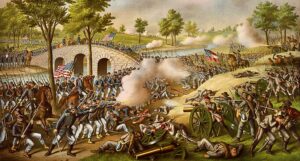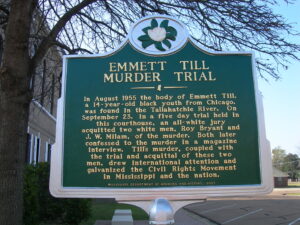
Silence in the Storm: The New York Times' Coverage of the Holocaust During WWII
The Watergate scandal began to break just as I began my freshman year at East Carolina University in 1972. The Washington Post was the first newspaper to recognize the significance of the story. The courage they showed in investigating the break-in at the Democratic National Headquarters in Washington and subsequent cover-up by the Nixon administration made heroes of the lead Watergate reporters, Bob Woodward and Carl Bernstein. Many young college students who had never thought of writing for newspapers now considered journalism careers because of the enormous impact of Watergate and Nixon’s resignation. I was one of those students. ECU lacked a journalism major, so I majored in Political Science and minored in Journalism.
In college, my admiration for the two leading national newspapers—the New York Times and the Washington Post—grew as I learned about each paper’s decision to publish the Pentagon Papers in 1971. Like their editors, I was convinced that the government’s lies about the Vietnam War justified the scrutiny publication ensured. Journalists like Woodward, Bernstein of the Post, and Neil Sheehan of the Times introduced me to other journalists who became favorites—David Halberstam, David Brinkley, James “Scotty” Reston, Art Buchwald, to name a few.
After graduation from ECU, my first two job offers came from a small-town newspaper in eastern North Carolina and an AM radio station. I turned both down. Believe it or not, working as a reporter for small-town newspapers and radio stations was not as lucrative as teaching. Over the years, I have befriended several people who made a different call, tolerated the low entry pay, paid their dues, and became successful reporters. They are—to a person—intelligent, hard-working, committed journalists of high integrity.
Consequently, I reject the popular notion that the media lies. Yes, some journalists have concocted stories. All journalists, like all people, have their own biases, and they make errors, but I reject the idea that they arrive on the job each day determined to twist the news in service of some grand agenda. On the other hand—not unlike historians who select sources they believe help explain the events of the past—there is bias in the stories that newspapers choose to print and twenty-four-hour news programs decide to broadcast. Decisions about how prominently to portray these stories and how often to follow up on the initial reporting are choices that may also reflect bias.
A case in point is the New York Times coverage of Adolph Hitler’s so-called Final Solution – the plan to exterminate all Jews living in Europe. According to Journalism Professor Laura Leff of Northeastern University, “No American newspaper was better positioned to highlight the Holocaust than the Times, and no American newspaper so influenced public discourse by its failure to do so.”
The New York Times, which began publishing in 1851, is regarded as one of the world’s best newspapers. Its reputation for reliable, comprehensive coverage was secure by the early 1940s. Its foreign correspondents, including 30 reporters stationed in Europe, were well-positioned to uncover and report the Holocaust. Indeed, the Times did not ignore the story. In fact, historian David Wyman argues that “the Times provided by far the most complete American press coverage of Holocaust events.” Yet, as Laura Leff points out in her book, Buried By The Times: The Holocaust and America’s Most Important Newspaper total coverage mattered less than the placement of the news and the frequency of stories about the Holocaust. Although the Times published nearly 1200 stories on the Holocaust during WWII, only 26 of 24,000 front-page stories dealt with the Holocaust, and many of those failed to report the targeting of Jews by the Nazi regime.
Leff also argues that scholars can best answer questions about the wartime coverage of the Holocaust by the press by examining one specific news outlet in-depth – such as the Times. “Deep-seated professional and cultural traditions play a part.” Leff writes. “But so do the idiosyncrasies of an individual newsroom. A publisher’s particular sensitivity, a managing editor’s preference for evenings at home, a nighttime editor’s religious orientation, and a reporter’s gambling habit can be as important in determining the contents of tomorrow’s paper as the need to attain a particular profit margin or maintain the appearance of objectivity.” These factors exist in addition to the petty jealousies and ambitions circulating in any large institution.
So why did the Times downplay the Holocaust during the War? What was the impact of this decision? In the decades following WWII, several reasons have been suggested for the Times’ editorial decisions about reports of what was happening to European Jews under Hitler’s reign. The sheer volume of news during WWII contributed to the Times’s thinking. The military maneuvers, the horrific death toll, and the incomprehensible level of destruction may have led some news organizations – including the Times – to think that by emphasizing what was happening to the Jews, they would enter an unseemly competition over which victims were suffering the most.
The press also recalled the numerous stories of atrocities during WWI and the Spanish Civil War that were false – mere propaganda designed to dehumanize the enemy. And the Times’ owners and editors may have been concerned that the level of anti-Semitism within the United States might undermine public support for the war – that too many Americans would not want their sons fighting to “save the Jews.” The U.S. government did not emphasize the war’s impact on Jews. Editors may have felt they were simply following the Roosevelt administration’s lead.
For journalists to act on the information they gather, they must evaluate the accuracy of the information, assess the credibility of their sources, and judge its relative importance – is there a public need to know or public interest in the story? In other words, is the information newsworthy? Reporters in the field must rely on their editor’s judgment about their reporting – does the editor or publisher agree that the reporter’s story is newsworthy?
Times reporters may have questioned the credibility of the reports of Jewish extermination, and the reports may have become subsumed by the catastrophic death tolls during the war. They and their editors may have felt that singling out the Jews as a target for extermination may not have had enough relative importance compared to the overall story of the war.
Then there is the impact of Arthur Hays Sulzberger, the CEO, and publisher of the Times. Sulzberger was Jewish. He believed Judaism was a religion and not a race or people – a belief Leff argues impacted his reluctance to emphasize the unique targeting of Jews by Hilter’s regime. Though Sulzberger worked to free some – though not all – of his Jewish relatives living in Europe, his paper never called for a large-scale effort to rescue the Jews enduring the extermination campaign. Could a single newspaper, even one as influential as the Times, have shifted public opinion about the Holocaust sufficiently to impact the government’s response to the Holocaust? We will never know, but the fact remains they chose not to try.
Neither did the United States government. Teaching American History sponsors One Day Seminars on FDR’s response to the Holocaust. Teachers examine primary sources detailing what the U.S. knew about the Nazi campaign against the Jews and why they chose neither to launch a rescue attempt nor bomb the death camps – as some Jewish groups suggested. In one of these seminars, the discussion leader, Dr. David Krugler, asked the teachers to say – if they were comfortable doing so – whether they would have wanted the Allies to bomb the camps had they been a victim. Krugler told us that a Holocaust survivor once attended this seminar. This survivor said he wished the Allies had bombed the camps even if the attack killed him. It would have served as “a moral condemnation of the Nazi’s Final Solution.” That’s the kind of statement too many in the world press were hesitant to put in their newspapers.



